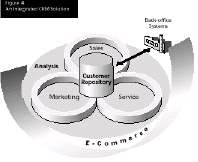|
|
 |
|
 CRM
& E-Commerce CRM
& E-Commerce
|
|
 |
|
|
3.1 CRM evolution
|
|
Many of today s major
trends cant ignore the web phenomenon and the drive of ecommerce.
This vast opportunity, mostly as yet unrevealed, manifests itself
as a significant aspect of almost all other major trends. The
concept of Customer Relationship Management with its three fundamental
pillars of Marketing, Sales, and Service clearly requires a
commerce strategy, which is now expanded to include web commerce,
i.e. ecommerce. Industry analysts are uniform in claiming that
e-commerce and CRM are complementary initiatives and will bring
faster ROI. However, statistics show that enterprises are slow
in merging these initiatives, causing uncoordinated error-prone
efforts that result in wasted time and dissatisfied customers.
It is actually quite astonishing that ... the majority of companies
are implementing the most critical customer contact vehicle
of all ecommerce independent of key customer relationship
initiatives. Giga Information Group, CRM Plus E-commerce Equals
Faster ROI, 8/99. In an article published September 99 titled
Realizing the Virtual Customer, MetaGroup explained that ...G2000
organizations implementing both customer relationship management
(CRM) and e-commerce (EC) initiatives often mistakenly treat
these initiatives separately.... It will also be increasingly
important to coordinate the purchasing (and processes) of both
CRM and EC capabilities to provide a panoramic customer view
to the enterprise. Bottom Line: Organizations must treat the
e-channel and EC as part of overall CRM strategy to avoid channel
conflict and optimize the return on customer relationship (ROCR).
|
|
|
 Responding
to the need to combine e-commerce and CRM initiatives, many
of the traditional CRM vendors are currently working on expanding
their CRM offering to the web. CRM has been around in one
form or another
for a long time. It is the emphasis that is being put on an
integrated CRM business strategy that encompasses all customer
touch points and particularly the web, that is requiring significant
modifications to the old time CRM
offerings. Many of the traditional CRM players are currently
playing catch-up as the rules of the game have changed. |
| |
|
 |
3.2 Integration & consistency is essential
Approaching e-commerce and CRM in an uncoordinated fashion can
create a frustrated unsatisfied customer. The enterprise business
must operate in concert coordinating the back-office systems
with the front-office and ecommerce strategies. See figure 4
for an integrated CRM solution. Customers want to be treated
with the same high quality, independent of their channel of
interaction. Whether they access the enterprise via the phone,
the web, or e-mail the customer expects a quick professional
response. The product and company information must be accurate
and consistent. There is nothing more distressing than getting
conflicting answers to the same question from different representatives
of the perceived source of authority. |
| In addition to annoying
the customer, the enterprise itself suffers from unnecessary
overhead and missed opportunities. Duplicate tasks and bottlenecks
are often a consequence of independent uncoordinated efforts
within the enterprise. Take for example the following missed
opportunity: A potential customer enters the web site and doesnt
spend the required amount of time on the right pages and doesnt
cooperate with filling in personal details other than a name.
Consequently, the prospect is not flagged as having a high potential
value. This prospect is therefore not sought after and is lost.
But in this hypothetical situation, it so happens that the prospect
is an existing Gold customer, who simply isnt particularly
web savvy, and therefore made a bad impression when analyzed
by the lead capture system. It also turns out that this prospect
actually was interested in a significant purchase. The information
about the prospects interests, buying habits and loyalty (until
that point) to the enterprise exists, but in a different database
handled by different people in the Customer Service department.
The loss to this particular enterprise by having independent
CRM and e-commerce initiatives is quite unfortunate. |
|
|
| Consistency when addressing
the customer across all media is important in several domains. |
|
|
a. Customer data
|
Customer data including
financial and demographic information must be kept up-to- date.
The information should be easily available to anyone within
the enterprise who might have customer contact. It is important
that relevant outstanding issues with the customer also be clearly
flagged. A customer shouldnt have to repeat a story or supply
an answer previously given to another representative.
|
b. Business rules
|
Business rules are often
dispersed within the organization causing inconsistent, uncoordinated
business decisions. Traditionally, business rule engines are
attached to each of the CRM components such as the Sales Automation
or Call Center systems. They frequently function correctly but
unfortunately independently of the larger enterprise picture.
|
c. Company and product information
|
| Both company and product
information must be kept up-to-date and consistent throughout
the enterprise. It is inconceivable that the web site will offer
a product that customer service knows nothing about, or that
a price quote given by a sales person contradicts a special
offer advertised on the web. Company information such as that
advertised in press releases should be easily available to all
that potentially interact with a customer. |
|
|
|
|